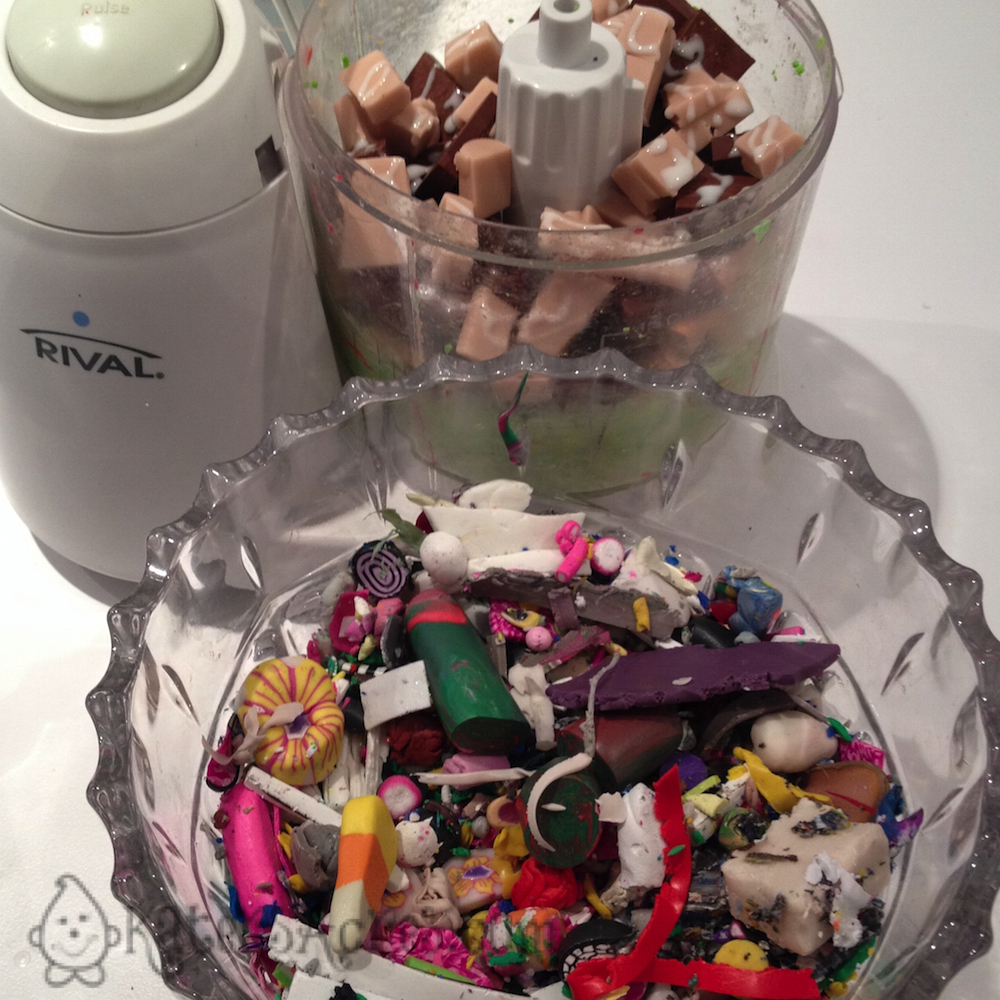
Blending Polymer Clay
One of the most time consuming parts about using scrap clay (for me at least) is blending it together. Why is this? Well, because often my clay just sits and waits on me. Some of the clay in my scrap clay pile is many years old. Other bits & pieces are fresh from recent sculptures or designs. But here’s my biggest tip for you … you know how I’m always telling you “Don’t use Sculpey” for your finished pieces? Well … when I have my students over in my studio, because they are mostly beginners, that’s all we use. When they get “good enough” that they aren’t wasting clay, I transition them to Premo or Fimo depending on their projects. Here’s the thing … every once and awhile you get a block of clay (it could be ANY brand) that is just too hard to condition! You run it through your pasta machine a zillion times and it’s still cracking, breaking, and just can’t get “warmed up” and softened.
When this happens there is only one solution … break out the good only trusty, ultra cheap, replace as needed food processor! There’s a few rules that you will need to abide by when using a food processor.
- The first is this: once you use it for clay, do NOT return it to your kitchen.
- Secondly: Get a cheap one because the “blending” parts of the processors are not clay safe. Any clay that you do not properly clean out of them will damage the plastic irreparably.
- Thirdly: Always clean it out immediately after use. Clean it out with a toothbrush, followed by a baby wipe soaked in rubbing alcohol.
- Fourthly: The blades are sharp! They will cut through your clay and your fingers! So please, be careful and use proper safety precautions.
Blending Polymer Clay Video
Because I haven’t made a video in awhile, here’s a really quick (1:27) video on what happens when you use this technique on rock hard polymer clay blocks with about 1/2 Tbs of (any brand) liquid clay added to the mix before blending.
The polymer clay blocks shown in this video are Sculpey III and are about 4 years old, rock hard, and impossible to blend.
Detailed Instructions for Blending Polymer Clay:
Start with a clean food processor dedicated to polymer clay.
- Attach clear bowl to unit and “lock” into place.
- Chunk your clay into many pieces (about 10-12 pieces per 2 oz. block).
- Carefully, insert your blade into the food processor unit.
- Place a maximum of 2.5 full blocks into a small 1 1/2 cup food processor.
- Squeeze approximately 1 Tbs. of liquid clay or TLS into your food processor on top of your clay.
- NOTE: I also added about 1 oz. of Super Sculpey to my mix because my clay was so hard. Read my Super Sculpey Secret here.
- Place the lid on your blender.
- Pulse away ….
- Continue pulsing until clay has formed tiny round balls, is warm to the touch, and sticks together when pinched.
- Remove clay from food processor and place onto work surface.
- RIGHT NOW: Go and clean the food processor before the clay begins to “melt” into the bowl.
- Gently smoosh all the little balls together and make a pancake.
- Using an acrylic brayer, roll over the top of your pancake to smoosh everything together.
- When the pancake is tightly smooched and about 1/4″ thick, begin to run it through your pasta machine.
- Do this until your sheet is nice, smooth, has a soft sheen, and does not crack when bent (about 20-40 times depending on amount of clay).
- Use this scrap blend for bead cores, armatures, or anything you’d like!
- Have fun & enjoy!
Thanks for joining me today,

[hr /]


You used the letters TLS in the directions :Squeeze approximately 1Ts of TLS in your processor on top of your clay.What is TLS mean ??????
Tiny Little Scraps ?
Tender loving screams?
Thick lush sandwich ?
Tuna Lettuce Salad ?
Ten little shrimp.? I really don’t know ?
TLS is “Transluscent Liquid Sculpey.” As the directions state, you can use any brand of liquid clay. Kato & Fimo liquid clays also work.
I’ve also heard that you can throw all of the scraps into a thick sandwich bag and put a couple drops of either oil (any type)or clay softener in with the mix. Let it sit for a few hours. If it needs more oil/softener, add a couple more drops at a time.
Once you feel it’s re-softened, you can run the bag (open the top of the bag so air can escape) full of scrap through a clay roller. You won’t gunk up your rollers this way.